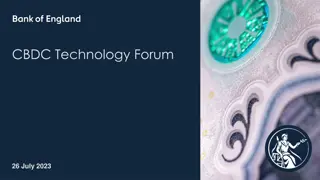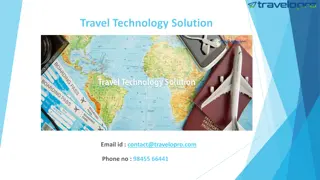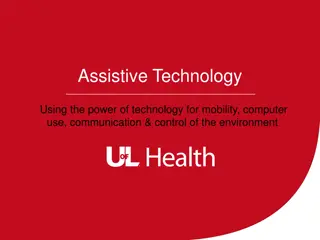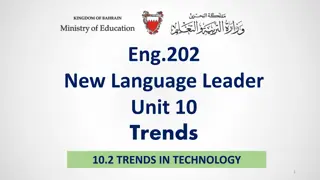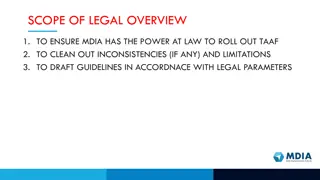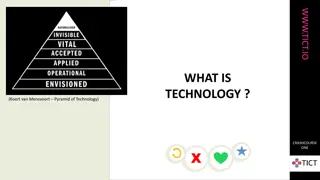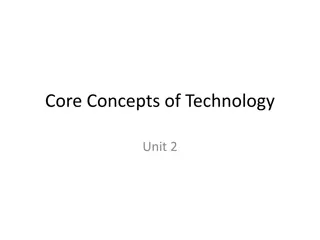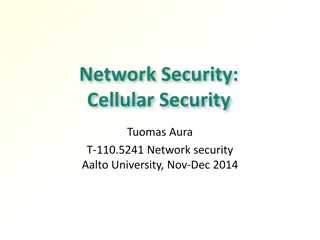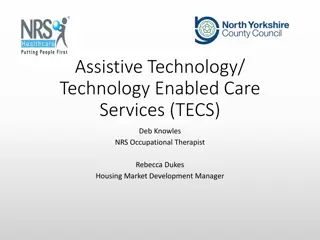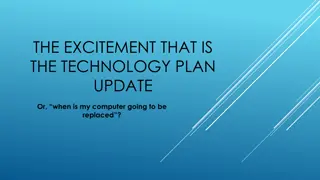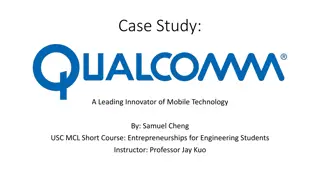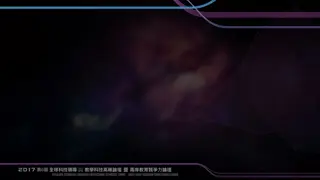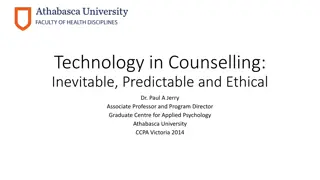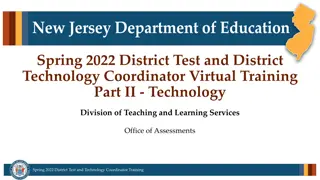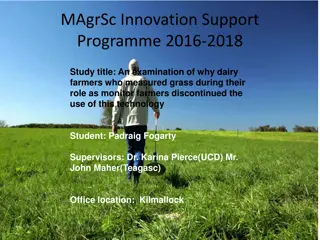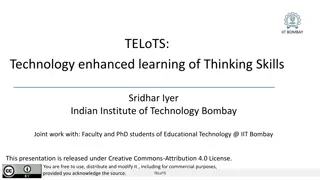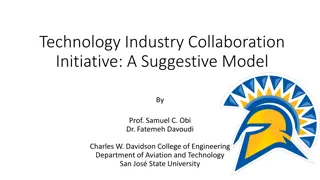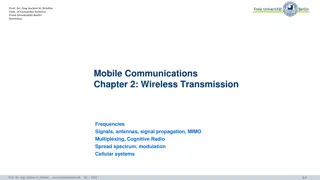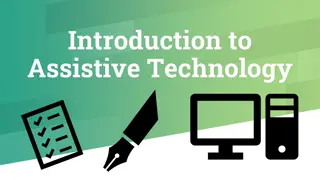UMTS and 3G Technology
Evolution and challenges of UMTS and 3G technology, from the dream of a universal standard to the reality of competing systems worldwide. Discover the development of Universal Mobile Telecommunications System (UMTS) as a generic name for 3G advancements, including the standards set by the International Telecommunication Union (ITU). Dive into the technical specifications, frequency spectrum, and network components defining the 3G UMTS standard. Learn about the ambitions and obstacles faced by the mobile telecommunications industry in achieving a unified and efficient mobile communication system.
Download Presentation

Please find below an Image/Link to download the presentation.
The content on the website is provided AS IS for your information and personal use only. It may not be sold, licensed, or shared on other websites without obtaining consent from the author.If you encounter any issues during the download, it is possible that the publisher has removed the file from their server.
You are allowed to download the files provided on this website for personal or commercial use, subject to the condition that they are used lawfully. All files are the property of their respective owners.
The content on the website is provided AS IS for your information and personal use only. It may not be sold, licensed, or shared on other websites without obtaining consent from the author.
E N D
Presentation Transcript
UMTS Justin Champion
3G UMTS Contents Why 3G UMTS Smart Antenna Use of UMTS at the moment
3G UMTS The Dream (intention) 2G and 2.5G systems are incompatible around the world. Worldwide devices need to have multiple technologies inside of them, i.e. tri-band phones, dual-mode phones To develop a single standard that would be accepted around the world One device should be able to work anywhere ! Access to Information from Anyplace, Anytime
3G UMTS The Dream (continued) Worldwide positioning available Able to pinpoint a device and direct services to it. Mostly to be used for Push services Increased data rate Maximum 2048Kbps Operational in Europe by 2002 Japan 2001 (this was achieved) Worldwide usage by 2005 (not going to happen)
3G UMTS The reality Different standards with some operators in America and the rest of the world In the future market forces may move towards a single standard i.e. VHS and Betamax video tapes Difficulties World wide identical available spectrum Agreement on the encoding/decoding technique used Local influence groups Manufacturers who have invested in one technology
3G UMTS Universal Mobile Telecommunications System (UMTS) Generic name for 3G developments Being developed by the European Telecommunications Standards Institute (ETSI) Based on the specifications of IMT-2000 developed by the International Telecommunications Union (ITU) Frequency Spectrum Technical Specification Radio and Network components Tariffs and Billing Technical Assistance
3G UMTS Standard The 3G stand was written by the International Telecommunication Union (ITU) The standard was referred to as IMT-2000 The key to the standards was the available data over the air interface 2Mbps in fixed or in-building environments 384 kbps in pedestrian or urban environments 144 kbps in wide area mobile environments Variable data rates in large geographic area systems (satellite)
3G UMTS Other parts of the standard Frequency Spectrum Technical Specification Radio and Network components Tariffs and Billing Technical Assistance 3 Main technical implementations were agreed UMTS - Europe CDMA2000 - America TD-SCDMA China
3G UMTS Universal Mobile Telecommunication system (UMTS) UMTS Builds upon the successful European GSM network Incorporates the developments made for the GPRS and EDGE networks Five areas of standardisation Radio Core Network Terminals Services
3G UMTS The core network Asynchronous Transfer Method (ATM) Has been defined as the core networking technology ATM allows circuit switched transfer of data using packets. High speed data transfer currently maximum 10 Gbps Guarantee of quality of service for the duration of packet transfer Small packets used called cells for the transfer of data to minimise the impact on the routers, network and switches. IPv6 Arguments are being pushed for the core network to allow IPv6 RFC3314, September 2002 This would allow packets to be transferred directly from the internet to the device with no translation IPv6 does contain QOS headers, which can be used with the correctly configured hardware All 3G devices could have a single IP address that would not need to change
3G UMTS UMTS Full packet driven architecture For voice and for data transmissions. Packet based networks allow for an increased amount of traffic on a medium. The only time part of that medium is blocked is when a device is transmitting or receiving. Consider how often in your phone calls you actually say nothing Natural pause between words Taking a breath Waiting for a response Thinking of something to say
3G UMTS UMTS Offers voice and data services the same as EDGE Services offered will be classed into one of the following Conversational Streaming Interactive Background Real-Time Best-effort, guarantee of quality delivery Web Pages Voice Streaming Video MMS, SMS, emails From these classes certain defined Quality of Service (QOS) specifications are guaranteed like packet delay time
3G UMTS Intended Data Rates Actual data rates will be effected by Interference (other devices, background, buildings) Over use of the frequency Amount of other traffic Base station / cell actually attached to Speed you are moving at !
3G UMTS Types of Cells and Base station to use them Macro Cell These cover a large area and will give slow access 144 Kbps max speed of 500 Km/h Micro Cell These should cover a medium area 384 Kbps max speed 120 Km/h Pico Cell Less than 100 metres 2 Mbps max speed of 10 Km/h Difficult to predict Actual distances and bandwidth depend on local conditions
3G UMTS Intended Data Rates Low 144 kbits/s satellite and rural outdoor Medium 384 kbits/s urban outdoor High 2048 kbits/s indoor and low range outdoor The speed that the device is moving at will effect the data rate Maximum movement speed for high date rate is 10 Kmph a fast walker will lose this rate
3G UMTS Types of Cells and Base station to use them Cells will operate in a hierarchy overlaying each other Global Satellite Suburban Urban In-Building Pico-Cell Micro-Cell Macro-Cell
3G UMTS Types of Cells and Base station to use them Cells will operate in a hierarchy overlaying each other Pico Cells will operate in a Time division Duplex (TDD) mode TDD mode will use the same frequency to send and receive with a time frame being allocated. All other cells will operate in Frequency Division Duplex (FDD) Mode FDD will operate in the same manner as GSM, with a different frequencies for the Uplink and Downlink
3G UMTS Consider These data rates are in Mega Bits per Second and Kilo Bits In terms of data rate the measure of a kilo bit is 1000 bits Not the 1024 which is used for data storage So 2 Mega Bits per Second = 244 Kilo Bytes per second (roughly)
3G UMTS What transmitters/base stations look like Pictures taken from (www.undetectables.co.uk, 2004)
3G UMTS Radio Interface Allocated Frequencies
3G UMTS Radio Interface These frequencies were auctioned at great expense Country Cost per population $ United Kingdom $594.20 Germany Italy S. Korea $566.90 $174.20 $60.80 The UK phone companies in June, 2003 said that they would claim the VAT back on the license purchases! About 4 Billion pounds Court case started on the 9th of Feb 2004
3G 3G spectrum auction License shows the size of the spectrum with A being the largest Part of the auction rules was a new company in the UK won the License type A Auction closed on the 27th April 2000 The UK phone companies in June, 2003 said that they would claim the VAT back on the license purchases! About 4 Billion pounds Court case started on the 9th of Feb 2004 License A B C D E Company TIW (3) Vodafone MM02 Paid (Pounds) 4,384,700,000 5,964,000,000 4,030,100,000 4,003,600,000 4,095,000,000 One2One (T-Mobile) Orange
3G UMTS UK 3G Winners ??
3G UMTS Radio Interface UMTS uses Wideband-Code Division Multiple Access (W- CDMA) Also known as IMT-2000 Direct Spread Extremely complex algorithms Uses 10x the current 2G processing power! Modulation is done with Quadrature phase shift keying (QPSK) This encodes 2 bits with each change Supports two modes of operation Frequency Division Duplex (FDD) Time Division Duplex (TDD)
3G UMTS Trivia Spread spectrum technology was patented by Actress Hedy Lamarr in 1942 She was the person who also gave us Cat woman out of the Batman comics!
3G UMTS W-CDMA Operates in the same manner as the CDMA used in the US CDMA allows multiple users to communicate at the same time over the same frequency Each of the devices is given a Chipping code this is known by the device and the base station. This chipping code is then used to identify the signal and allows the BS to receive the signal The chipping code is used to adjust the frequency of data transferred during the transfer The essential point of CDMA is the use of power control
3G UMTS W-CDMA Wideband CDMA operates the same but this takes place over a wider area of frequency UMTS uses 5MHz for the signal CDMA (narrowband) uses 200 KHz These communications are secure by the nature that unless the chipping code is known, the sequence of the data can not be known Communications can take place as soon as the device is ready and frequency reuse factor is now one
3G UMTS W-CDMA Frequency Reuse Factor This is the distance which needs to be left between cells As the same frequency is reused and the chipping code which is used is change and unique to a BS The frequency can be reused in adjoining cells Temporary Base stations can be added to the infrastructure if required, as long as the chipping code was unique
3G UMTS Power Control If you consider a group of people speaking, Chinese, English and Italian If these all speak at the same volume you can then listen for the parts which you understand. If the English person starts talking louder than the rest, the all you will hear is English The other languages will be drowned out CDMA Works on the same basis One point of CDMA is the power control, so that the power sent out is just enough to allow data transfer to take place. As a side effect of this technology this controlling of the power that the radio interface uses, also saves the battery on the device
3G UMTS Radio Interface Smart Antenna technology These will allow the maximum radio efficiency Traditional Antenna s are omni-directional They transfer the radio signal in 3600 from the transmission point Top View Side View
3G UMTS Radio Interface Smart Antenna Increase the quality of the signals Only installed at the BS, not the handset Increase the usage of the BS Increased frequency reuse
3G UMTS Radio Interface Smart Antenna Two types at the moment Switched Beam A finite number of patterns or technologies are built into these Adaptive Array Infinite Number of patterns available, these patterns will adjust in real-time to conditions
3G UMTS Adaptive Array Antenna Switched Beam (http://www.iec.org/online/tutorials/smart_ant/topic03.html, 2003)
3G UMTS Smart Antenna Benefits (www.iec.org/online/tutorials/smart_ant/topic04.html, 2003) Feature Benefit signal gain Inputs from multiple antennas are combined to optimize available power required to establish given level of coverage. better range/coverage Focusing the energy sent out into the cell increases base station range and coverage. Lower power requirements also enable a greater battery life and smaller/lighter handset size. interference rejection Antenna pattern can be generated toward co channel interference sources, improving the signal-to-interference ratio of the received signals. increased capacity Precise control of signal nulls quality and mitigation of interference combine to frequency reuse reduce distance (or cluster size), improving capacity. Certain adaptive technologies (such as space division multiple access) support the reuse of frequencies within the same cell. spatial diversity Composite information from the array is used to minimize fading and other undesirable effects of multi path propagation. Multi Path rejection can reduce the effective delay spread of the channel, allowing higher bit rates to be supported without the use of an equalizer power efficiency combines the inputs to multiple elements to optimize available processing gain in the downlink (toward the user) reduced expense Lower amplifier costs, power consumption, and higher reliability will result.
3G UMTS Radio Interface Smart Antenna Switched Beam Multiple direction orientated fixed beams Multiple beams can be combined to improve the quality of the signal Each of the beams is referred to as a Macro sector The macro sector with the strongest signal in the centre of the antenna will be the one which communications will be directed through As the user moves the Macro sector to the new highest power Done by monitoring the strength of the signal Darker colour shows more sensitive part of antenna
3G UMTS Radio Interface Adaptive Array Antennas These devices track a communicating device The power can be adjusted to exactly what is required for successful communications They can minimise interference by controlling the power in a particular direction The transmission of the signal can be directed to the user and follow them. This removes any interference from other users Reduces the effect of signal propagation As the signal is directed
3G UMTS Advantages Integration Switched beam can be added to current infrastructure Adaptive antenna, require consideration to the network and there use Range Switched beam can increase range between 20 200% over a normal cell Depending on local conditions Switched beam power can not be adapted as the user moves, as the power and shape are pre-defined Adaptive Array can cover larger area due to the directing of the signals to a device Interference Suppression Switched beam Interference from beams which are away from where they are expected are ignored As the beams are pre-determined at the development stage, interference is still possible Switched Beam has problems with interference from device which are close to the BS Adaptive array is more resistant to interference as the signal is narrowed towards the actual device Capacity See next slide
3G UMTS Smart Antenna Capacity Spatial Division Multiple Access (SDMA) More efficient use of the allocated frequency By controlling Amount of interference Multi-path Propagation Multi-path interference Allowing 2 users in the same cell to use the same transmission slot Potentially having a single user per allocation slot This is more of a consideration with WCDMA rather than GSM tech
3G UMTS Smart Antenna Where can this technology be used? Although it is now being discussed for 3G It can be use anywhere GSM, GPRS, EDGE, PDC UMTS, CDMA2000 WI-FI, HIPERLAN The technology is now coming available and this respect it is considered more for 3G
3G UMTS W-CDMA Infrastructure
3G UMTS W-CDMA UTRAN The core network for 3G will remain the same as GSM This is a purely cost issue, in the future the infrastructure will be upgraded GSM UMTS Mobile device/station (MS) Base Station (BS) Base Station Controller (BSC) User Equipment (UE) Node-B Radio Network Controller (RNC)
3G UMTS W-CDMA UMTS Terrestrial Radio Access Network (UTRAN) A device which wishes to communicate need s to request access to the network This is to prevent too many devices communicating at once Although CDMA will theoretically allow a very large number of user to communicate at once What actually happens is the quality of the calls is reduced considerably This is a issue for voice but is a disaster for data calls
3G UMTS W-CDMA Handover UMTS will use a soft handover technique GSM used a hard handover technique In a handover the device is always attached to at least one BS Node-B Node-B Node-B Node-B Node-B Node-B
3G UMTS Virtual Home As a part of the ITU standard the Virtual Home Environment (VHE) will be supported. In 2G a VLR was used to allow the transfer of personal information A VHE will take this one stage further This will provide a common look and feel interface This is independent of the location, connecting network and device It is envisaged that this will be used on both circuit switched and packet switched networks How this will be achieved is undecided at the moment
3G UMTS 3G UMTS is working in one part of the UK Isle of man has the equipment to use 3G This equipment is run and operated by O2 The license spectrum used on this island was given free by the government The actual devices used were given to some of the islanders The idea was to trial the equipment in a limited manner Also they wanted to see if there was a pattern of usage for the technology i.e. the killer app As it is known now they have not found the single killer app, like SMS was for GSM Japan When we consider Japan for the killer app it was email! 3G bandwidth is not needed for email!
3G UMTS UMTS Worldwide usage
UMTS Links Details of the 3G license auction (UK) www.umts-forum.org/servlet/dycon/ztumts/umts/Live/en/umts/Resources_Licensing_UK UMTS standards documents www.3gpp2.org/Public_html/specs/index.cfm


